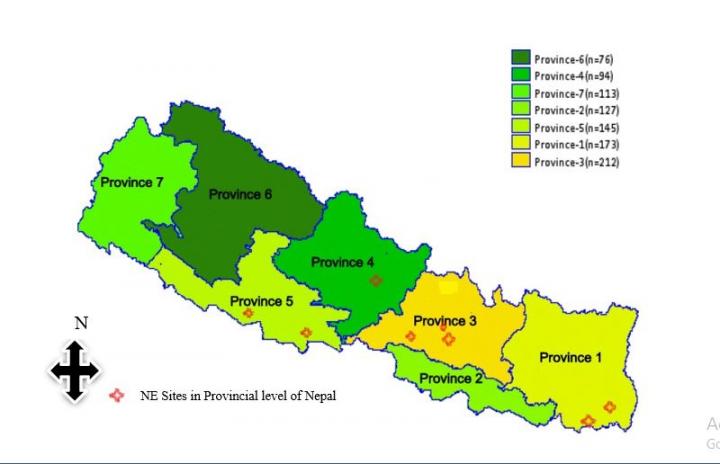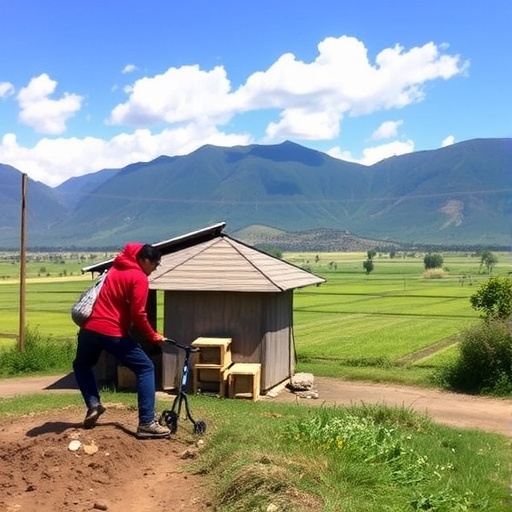
Credit: © Amgain Lal Prasad
Rice farmers in Nepal are chronically falling short of their potential productivity. Poor rice yields are persistent across the Terai–a lowland region lying south of the outer foothills of the Himalayas that extends through southern Nepal into northern India–and existing decision support systems are failing to provide the precision required.
To date, farmers in the area have lacked the knowledge and support they need to properly plan nutrient applications for their crops. Current nutrient recommendation systems only provide “blanket” prescriptions that fail to consider the large variability that occurs across their rice-growing landscapes. Nepal’s rice yield gaps–the difference between actual and attainable yields–are widening as soil fertility declines, which represents a major threat to the sustainability of these smallholder farms.
A team of researchers, headed by Dr. Lal Prasad Amgain, Far Western University, Nepal, along with Dr. Jagdish Timsina, Global Evergreening Alliance, Melbourne, Australia, looked at reversing this trend through the implementation of a flexible nutrient recommendation system that can adapt to the unique conditions faced by individual smallholder farmers.
Published in the Journal of Plant Nutrition, the article describes the impact of a 4-year study conducted across the Terai and the central mid-hill regions of Nepal. The basis for study is a broadly field-tested digital tool called Nutrient Expert® (NE).
This software-based system leads individual farmers, or farm advisors, through a step-by-step decision-making process that describes how best to apply nutrients to their rice fields. Prior to its introduction into Nepal, NE Rice has been successfully implemented in India, Bangladesh, Sri Lanka, as well as in China. The tool has been proven effective in a variety of smallholder cropping systems.
“Soil nutrient supply often varies greatly between neighboring fields,” explains Dr. Sudarshan Dutta, co-author of the study and Scientist at the African Plant Nutrition Institute (APNI). “This study adds innovation to the process of fertilizer application through the use of a tailored, scientifically robust approach.”
During the study, NE-based recommendations increased yields by over 2 t/ha compared to the status quo of farmers applying fertilizer based on either informal knowledge or generalized recommendations.
Given that the size of the yield gap for rice in Nepal is estimated at 3 t/ha, the NE approach shows great potential for contributing to the country’s nutrient security goals if adopted on a wider scale. The economics of the approach also proved attractive as NE was capable of doubling rice crop profitability if compared to the generalized recommendations.
“Nutrient Expert gives farmer’s the confidence that they are using nutrients in the right way,” explains Dr. Kaushik Majumdar, APNI Director General, and co-author of the study. “The tool also provides farmers with a clear plan on how to best match the timing of their applications with the periods of peak nutrient demand, which is a critical step to ensuring fertilizers are used most effectively.”
With these positive results in hand, researchers are looking to expand the effort through additional research on rice and other cereals.
“On-farm demonstrations provide the evidence that farmers, farm advisors, and other stakeholders need to pave the way for expanded adoption of the NE-based nutrient recommendations across Nepal,” concluded Dr. Dutta.
###
The team was comprised of researchers from the Institute of Agriculture and Animal Sciences (IAAS), Tribhuvan University, Chitwan, Nepal; Institute for Studies and Development Worldwide, Sydney, Australia; African Plant Nutrition Institute, Benguérir, Morocco; and Mohammed VI Polytechnic University, Benguérir, Morocco. This research was first introduced in Nepal by the International Plant Nutrition Institute (IPNI) and the Non-resident Nepalese Association (NRNA) Australia, and was locally managed by FORWARD-Nepal.
Media Contact
Gavin Sulewski
[email protected]
Original Source
https:/
Related Journal Article
http://dx.




